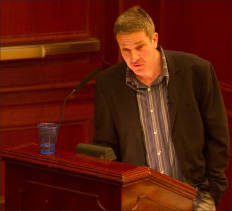
By Chloe Nouvelle
Correspondent
In the most recent installment of the Brown Bag Series, associate professor of music Wayne Heisler discussed the connection of music to dance in his lecture, “Dancing Richard Strauss’s ‘Four Last Songs.’”
In his lecture, Heisler defined a “song ballet” as “choreographies of textual art, folk or popular music.”
The music provided for the dancers during practice of the choreography was often “generic dance music,” Heisler said.
John Laughton, dean of the School of Arts and Communication, encouraged students to think about the settings that provided the backdrops for ballets. He compared them to movie scenes.
“Think about motion picture scenes and how they were conceived,” Laughton said.
Heisler explained that before the 20th century, it was only after the dances were conceptualized, practiced and produced that music was created to fit the dance.
In the 20th century, music and choreography began to be “created in dialogue,” Heisler said.
Strauss’s “Four Last Songs,” created between 1946 and 1948, are “Frühling” (Spring), “September,” “Beim Schlafengehen” (Going to Sleep) and “Im Abendrot” (At Sunset).
Heisler discussed the choreographer’s works in relation to Strauss’s “Four Last Songs,” and their choreographical composition in relation to the lyrical composition of Strauss’s songs.
One choreographer discussed was Maurice Béjart, with a focus on his 1970 work “Serait- ce La Mort” (Could This Be Death).
Heisler described Béjart’s work composing ballet dance to text and music as “prolific.”
Heisler noted Béjart as being recognized for his “dance centered spectacles” and “venue specific choreography.”
Heisler showed the audience both musical and visual excerpts in order to convince the audience of his argument.
In the clip from Béjart’s “Serait-ce La Mort,” Heisler said Béjart “explored relationships between word, voice and body” through his composition of dance movements.
Heisler also focused on choreographer Rudi van Dantzing’s 1977 “Vier letzte Lieder,” (Four Last Songs) and described his composition of movements as a “concert of organic unity.”
Heisler said van Dantzing’s choreography was “lyrical” and “as if something breathed by music on stage.”
Heisler explained these song ballets of Béjart and van Danzing as having “textual narratives.”
Laughton said as he introduced the lecture that the “word music is synonymous with dance,” and noted the College’s intent to bring “movement into the school as much as possible.”
Laughton also noted the College would be looking into developing dance classes as part of the “regular curriculum,” as well as a performance minor.
When asked how he felt about the lecture, sophomore music major Dylan Lloyd said, “I thought it was very informative on how music, dance and the stage are all related.”






